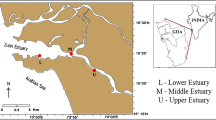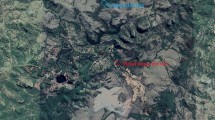Abstract
This study was conducted on Holothuria polii, Holothuria tubulosa, and Holothuria mammata collected from five stations with different depths in the Northern Mediterranean Sea. The body walls and guts of these holothurians were examined in terms of interactions of 10 metals (iron (Fe), copper (Cu), manganese (Mn), zinc (Zn), chromium (Cr), cobalt (Co), vanadium (V), nickel (Ni), cadmium (Cd), and lead (Pb)) and one metalloid (arsenic (As)) using a multivariate analysis, and interspecies differences were determined. The multivariate analysis of variance (MANOVA) revealed significant differences between the species in terms of metal(loid) accumulations. The principal component analysis (PCA) showed a more association between H. tubulosa and H. polii with regard to the accumulation. The cluster analysis (CA) located Pb concentrations of the guts to the farthest place from all elements regardless of the species. A correlation analysis displayed that the element concentrations of the guts were more closely related to each other compared with those of the walls. The most inconsistent element in terms of correlations was the gut Fe contents. Accordingly, while Fe concentrations of H. mammata and H. tubulosa were correlated with all elements (except Pb) in divalent metal transporter 1 (DMT1) (divalent cation transporter 1 (DCT1) or natural resistance-associated macrophage protein 2 (NRAMP2)) belonging to the NRAM protein family, this was not the case in H. polii. Consequently, significant relationships between accumulated metal(loid)s that changed by tissues and sea cucumber species were observed.





Similar content being viewed by others
References
Abbas Alkarkhi FM, Ismail N, Easa AM (2008) Assessment of arsenic and heavy metal contents in cockles (Anadara granosa) using multivariate statistical techniques. J Hazard Mater 150:783–789
Ahearn GA, Mandal PK, Mandal A (2004) Mechanisms of heavy-metal sequestration and detoxification in crustaceans: a review. J Comp Physiol B 174:439–452
Andreini C, Bertini I, Cavallaro G, Holliday GL, Thornton JM (2008) Metal ions in biological catalysis: from enzyme databases to general principles. J Biol Inorg Chem 13:1205–1218
Aydın M (2008) The commercial sea cucumbers fishery in Turkey SPC Beche de Mer. Information Bulletin 28:40–43
Aydın M, Erkan S (2015) Identification and some biological characteristics of commercial sea cucumber in the Turkey coast waters. International Journal of Fisheries and Aquatic Studies 3:260–265
Bridges CC, Zalups RK (2005) Molecular and ionic mimicry and the transport of toxic metals. Toxicol Appl Pharmacol 204:274–308
Conand C (2006) Sea cucumber biology: taxonomy; distribution; biology; conservation status. In Bruckner A.W. (ed.). The proceedings of the CITES workshop on the conservation of sea cucumbers in the families Holothuriidae and Stichopodidae OAA Technical Memorandum. 33–50.
Conti ME, Bocca B, Iacobucci M, Finoia MG, Mecozzi M, Pino A, Alimonti A (2010) Baseline trace metals in seagrass, algae, and mollusks in a southern tyrrhenian ecosystem (Linosa Island, Sicily). Arch Environ Contam Toxicol 58:79–95
Costa Pessoa J, Garribba E, Santos MFA, Santos S (2015) Vanadium and proteins: uptake, transport, structure, activity and function. Coord Chem Rev 301:30249–30286
Da Silva JAL (2012) Vanadium in biology: its chemistry and some of its contributions on environmental cycles of chemical elements. In: Vanadium: chemical properties, uses and environmental effects, pp. 1–25.
De Oliveira LM, Gress J, De J, Rathinasabapathi B, Marchi G, Chen Y, Ma LQ (2016) Sulfate and chromate increased each other’s uptake and translocation in As-hyperaccumulator Pteris vittata. Chemosphere 147:36–43
Fikirdeşici Ergen Ş, Üçüncü Tunca E, Ozkan AD, Ölmez TT, Acaröz E, Altındağ A, Tekinay T, Tunca E (2015) Interactions between metals accumulated in the narrow-clawed crayfish Astacus leptodactylus (Eschscholtz, 1823) in Dikilitaş Lake, Turkey. Chem Ecol 31:455–465
Garrick MD, Singleton ST, Vargas F, Kuo HC, Zhao L, Knöpfel M, Davidson T, Costa M, Paradkar P, Roth JA, Garrick LM (2006) DMT1: which metals does it transport? Biol Res 39:79–85
Givianrad MH, Larijani K, Jamili S, Adeli B (2014) Assessment of heavy metals by ligand-less cloud point extraction in sediment and Holothuria parva (Echinodermata, Holothuroidea). Indian J Geo-Mar Sci 43:825–830
Gonzalez-Wanguemert M, Aydın M, Chantal C (2014) Assessment of target sea cucumber populations from Aegean Sea (Turkey): first insights for a right management of their fisheries. Ocean & Coastal Management 92:87–94
Guner U (2007) Freshwater crayfish Astacus leptodactylus (Eschscholtz, 1823) accumulates and depurates copper. Environ Monit Assess 133:365–369
Illing AC, Shawki A, Cunningham CL, Mackenzie B (2012) Substrate profile and metal-ion selectivity of human divalent metal-ion transporter-1. J Biol Chem 287:30485–30496
Jinadasa BKKK, Samanthi RI, Wicramsinghe I (2014) Trace metal accumulation in tissue of sea cucumber species; north-western sea of Sri Lanka. American Journal of Public Health Research 2:1–5
Kawakami N, Ueki T, Matsuo K, Gekko K, Michibata H (2006) Selective metal binding by vanabin2 from the vanadium-rich ascidian, Ascidia sydneiensis samea. Biochim Biophys Acta, Gen Subj 1760:1096–1101
Kitayama H, Yamamoto S, Michibata H, Ueki T (2013) Metal ion selectivity of the vanadium(v)-reductase vanabin2. Dalton Trans 42:11921–11925
Kouba A, Buřič M, Kozák P (2010) Bioaccumulation and effects of heavy metals in crayfish: a review. Water Air Soil Pollut 211:5–16
Kramer U, Talke IN, Hanikenne M (2007) Transition metal transport. FEBS Lett 581:2263–2272
Liu Y, Zhou Q, Xu J, Xue Y, Liu X, Wang J, Xue C (2016) Assessment of total and organic vanadium levels and their bioaccumulation in edible sea cucumbers: tissues distribution, inter-species-specific, locational differences and seasonal variations. Environ Geochem Health 38:111–122
Liu Y, Zhou Q, Zhao Y, Wang Y, Wang Y, Wang J, Xu J, Xue C (2015) Enrichment, distribution of vanadium-containing protein in vanadium-enriched sea cucumber Apostichopus japonicus and the ameliorative effect on insulin resistance. Biol Trace Elem Res. doi:10.1007/s12011-015-0517-y
Lopez FJS, Garcia MDG, Vidal JLM, Aguilera PA, Frenich AG (2004) Assessment of metal contamination in Donana National Park (Spain) using crayfish (Procamburus clarkii). Environ Monit Assess 93:17–29
MacTavish T, Stenton-Dozey J, Vopel K, Savage C (2012) Deposit-feeding sea cucumbers enhance mineralization and nutrient cycling in organically-enriched coastal sediments. PLoS One 7:e50031
Martinez-Finley EJ, Chakraborty S, Fretham SJB, Aschner M (2012) Cellular transport and homeostasis of essential and nonessential metals. Metallomics 4:593–605
Mathies G, Gast P, Chasteen ND, Luck AN, Mason AB, Groenen EJJ (2015) Exploring the Fe(III) binding sites of human serum transferrin with EPR at 275 GHz. J Biol Inorg Chem 20:487–496
McAloon KM, Mason RP (2003) Investigations into the bioavailability and bioaccumulation of mercury and other trace metals to the sea cucumber, Sclerodactyla briareus, using in vitro solubilization. Mar Pollut Bull 46:1600–1608
Menon AV, Chang J, Kim J (2016) Mechanisms of divalent metal toxicity in affective disorders. Toxicology 339:58–72
Mims MP, Prchal JT (2005) Divalent metal transporter 1. Hematology 10:339–345
Mohammadizadeh M, Bastami KD, Ehsanpour M, Afkhami M, Mohammadizadeh F, Esmaeilzadeh M (2015) Heavy metal accumulation in tissues of two sea cucumbers, Holothuria leucospilota and Holothuria scabra in the northern part of Qeshm Island, Persian Gulf. Mar Pollut Bull 103:354–359
Morina A, Morina F, Djikanović V, Spasić S, Krpo-Ćetković J, Lenhardt M (2016) Seasonal variation in element concentrations in surface sediments of three rivers with different pollution input in Serbia. J Soils Sed 16:255–265
Nakayama SMM, Ikenaka Y, Muzandu K, Choongo K, Oroszlany B, Teraoka H, Mizuno N, Ishizuka M (2010) Heavy metal accumulation in lake sediments, fish (Oreochromis niloticus and Serranochromis thumbergi), and crayfish (Cherax quadricarinatus) in Lake Itezhi-tezhi and Lake Kariba, Zambia. Arch Environ Contam Toxicol 59:291–300
Neelam V, Hardaway CJ, Richert JC, Sneddon JA (2010) Laboratory controlled study of uptake of copper, lead, and zinc in crawfish (Procambrus clarkii) by inductively coupled plasma optical emission spectrometry. Anal Lett 43:1770–1779
Purcell SW, Samyn Y, Conand C (2012) Commercially important sea cucumbers of the world. FAO Species Catalogue for Fishery Purposes. No. 6. FAO, Rome, 150 pp. 30 colour plates.
Quarles Jr CD, Marcus RK, Brumaghim JL (2011) Competitive binding of Fe3+, Cr3+, and Ni2+ to transferrin. J Biol Inorg Chem 16:913–921
Rodriguez-Hernandez MC, Bonifas I, Torre Alfaro De La MC, Flores-Flores JL, Bañuelos-Hernández B, Patiño-Rodríguez O (2015) Increased accumulation of cadmium and lead under Ca and Fe deficiency in Typha latifolia: a study of two pore channel (TPC1) gene responses. Environ Exp Bot 115:38–48
Rzymski P, Niedzielski P, Klimaszyk P, Poniedzialek B (2014) Bioaccumulation of selected metals in bivalves (Unionidae) and Phragmites australis inhabiting a municipal water reservoir. Environ Monit Assess 186:3199–3212
Smyth DJ, Glanfield A, McManus DP, Hacker E, Blair D, Anderson GJ, Jones MK (2006) Two isoforms of a divalent metal transporter (DMT1) in Schistosoma mansoni suggest a surface-associated pathway for iron absorption in schistosomes. J Biol Chem 281:2242–2248
Tripathi RD, Srivastava S, Mishra S, Singh N, Tuli R, Gupta DK, Maathuis FJM (2007) Arsenic hazards: strategies for tolerance and remediation by plants. Trends Biotechnol 25:158–165
Tunca E, Ucuncu E, Kurtulus B, Ozkan AD, Atasagun S (2013a) Accumulation trends of metals and a metalloid in the freshwater crayfish Astacus leptodactylus from Lake Yenicaga (Turkey). Chem Ecol 29:754–769
Tunca E, Ucuncu E, Ozkan AD, Ulger ZE, Tekinay T (2013b) Tissue distribution and correlation profiles of heavy-metal accumulation in the freshwater crayfish Astacus leptodactylus. Arch Environ Contam Toxicol 64:676–691
Turk Culha S, Dereli H, Karaduman FR, Culha M (2016) Assessment of trace metal contamination in the sea cucumber (Holothuria tubulosa) and sediments from the Dardanelles Strait (Turkey). Environ Sci Pollut Res Int. doi:10.1007/s11356-016-6152-0
Ueki T, Kawakami N, Toshishige M, Matsuo K, Gekko K, Michibata H (2009) Characterization of vanadium-binding sites of the vanadium-binding protein vanabin2 by site-directed mutagenesis. Biochim Biophys Acta, Gen Subj 1790:1327–1333
Ueki T, Shintaku K, Yonekawa Y, Takatsu N, Yamada H, Hamada T, Hirota H, Michibata H (2007) Identification of vanabin-interacting protein 1 (VIP1) from blood cells of the vanadium-rich ascidian Ascidia sydneiensis samea. Biochim Biophys Acta, Gen Subj 1770:951–957
Ueki T, Yamaguchi N, Romaidi Isago Y, Tanahashi H (2015) Vanadium accumulation in ascidians: a system overview. Coord Chem Rev 301–302:300–308
Varmuza K, Filzmoser P (2009) Introduction to multivariate statistical analysis in chemometrics. CRC, Boca Raton
Waldron KJ, Rutherford JC, Ford D, Robinson NJ (2009) Metalloproteins and metal sensing. Nature 460:823–830
Warnau M, Dutrieux S, Ledent G, Rodriguez Y, Baena AM, Dúbois P (2006) Heavy metals in the sea cucumber Holothuria tubulosa (Echinodermata) from the Mediterranean Posidonia oceanica ecosystem: body compartment, seasonal, geographical and bathymetric variations. Environ Bioindic 1:268–285
Weng N, Wang W-X (2014) Variations of trace metals in two estuarine environments with contrasting pollution histories. Sci Total Environ 485–486:604–614
Yap CK, Edward FB, Tan SG (2010) Similarities and differences of metal distributions in the tissues of molluscs by using multivariate analyses. Environ Monit Assess 165:39–53
Yoshihara M, Ueki T, Watanabe T, Yamaguchi N, Kamino K, Michibata H (2005) Vanabin P, a novel vanadium-binding protein in the blood plasma of an ascidian, Ascidia sydneiensis samea. Biochim Biophys Acta, Gene Struct Expression 1730:206–214
Yoshihara M, Ueki T, Yamaguchi N, Kamino K, Michibata H (2008) Characterization of a novel vanadium-binding protein (VBP-129) from blood plasma of the vanadium-rich ascidian Ascidia sydneiensis samea. Biochim Biophys Acta, Gen Subj 1780:256–263
Zitka O, Krystofova O, Hynek D, Sobrova P, Kaiser J, Sochor J, Zehnalek J, Babula P, Ferrol N, Kizek R, Adam V (2013) Metal transporters in plants. Springer, Berlin, pp. 19–41
Acknowledgments
This study was supported by Istanbul University’s Research Fund (Project Number: 50025/2352) and Ordu University’s Research Fund (Project Number: AR-1501). We are grateful to Dr. Tatsuya UEKI for his support.
Author information
Authors and Affiliations
Corresponding author
Ethics declarations
Conflict of interest
The authors declare that they have no conflicts of interest.
Additional information
Editorial Responsible: Elena Maestri
Rights and permissions
About this article
Cite this article
Tunca, E., Aydın, M. & Şahin, Ü. Interactions and accumulation differences of metal(loid)s in three sea cucumber species collected from the Northern Mediterranean Sea. Environ Sci Pollut Res 23, 21020–21031 (2016). https://doi.org/10.1007/s11356-016-7288-7
Received:
Accepted:
Published:
Issue Date:
DOI: https://doi.org/10.1007/s11356-016-7288-7




